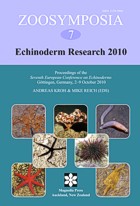Abstract
To elucidate growth and gonad development of Hemicentrotus pulcherrimus in the bed of Eisenia bicyclis, we examined gonad indices, gonad histology, gut content indices and ages of the sea urchins collected approximately monthly from March 2008 to September 2009 in Kitsunezaki in the Oshika Peninsula, northern Japan. We also monitored the densities of the kelp in six 1 m2 quadrates. The kelp at 1- to 3-years of age decreased in density from January to July due to strong wave action. The urchin test diameters at 1-, 2- and 3-years of age were 12.7 mm, 23.7 mm and 30.5 mm, respectively and these growth rates were equal to that measured in Sargassum beds in previous studies. The gonad recovering stage was classified into the two sub-class stages; the recovering I stage with relict spermatozoa or ova surrounded by renewed nutritive phagocytes, and the recovering II stage with nutritive phagocytes filling the lumen. The recovering I stages was prolonged from February to April when the gonad indices were around 10 % of total body weight, then rose sharply through the recovering II stage during May to August and the growing stage until October. The gonad indices rose sharply from November and reached a maximum of 18.8 in December when the gonad shifted from the premature to mature stages, then fell in January at the partly spawned and spent stages. Gut content indices were high at the recovering I stage, suggesting high availability of the drift thalli and lateral blades dislodged from the kelps and accumulation of nutrients in nutritive phagocytes.

